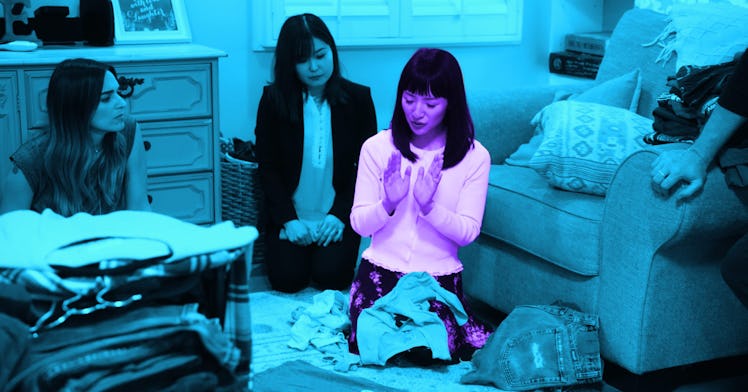Marie Kondo Has Made a Mess of My Happy, Cluttered Home
The new Netflix sensation might be good for some, but I can't find my beard trimmer. And I bet I'm not alone.

Marie Kondo and her Netflix series Tidying Up, have infiltrated millions of homes this month. Her unique method of organizing household clutter has resulted in tons of people throwing out junk they probably don’t need. This is great, I’m sure. But, as a father of a toddler, and the husband of a wife who has just binged the series, I suddenly feel like Marie Kondo has taken all my shit and hidden it. Kondo’s methods might be fine for individuals, but what about families?
Thanks to the hit Netflix show, the word “KonMari” has entered the vocabulary of countless households. For me, it’s a word that is usually preceded by a hashtag and followed by an expletive::“Where’s my beard trimmer? Please tell me you’re not going to #KonMari the fucking bathroom!” I am suddenly in a perpetual struggle to find things, from a frying pan to a pair of shoes for my toddler, and yes, a beard trimmer, because my wife has been KonMari-ing our house. If you’re among the lucky few who canceled your Netflix subscription or simply hasn’t fallen under the Kondo spell, let me fill you in on what is going on.
Marie Kondo is a professional organization consultant and the author of several books on the subject, most notably, The Life-Changing Magic of Tidying Up, which has sold 1.5 million copies in the United States alone. Kondo has borrowed some of her ideas from the ancient Japanese religion Shintoism, having served five years as a supplemental priestess at a Shinto shrine. The Shinto belief is that objects contain various gods (called Kamis) and ancestors with supernatural powers. How did Kondo’s version of this get started? According to CTBoom, her tidying-up epiphany was closer to a religious revelation than any kind of exact science. “I had a kind of nervous breakdown and fainted. I was unconscious for two hours,” she says. “When I came to, I heard a mysterious voice, like some god of tidying telling me to look at my things more closely.”
Each episode of the Netflix series sees Kondo helping out a particular case and begins with her introducing herself to the home she is charged with making over. Bowing down, palms on the floor, and speaking through a translator, Kondo says, “This is a ritual I do before we begin…picture your vision for your home. Communicate that with your home.” The American couple always plays along politely before rifling through all of their belongings, trying to determine which of their objects “spark joy”. Those that don’t get thrown away.
Americans are, as is often the case, simply taking things too far. After all, just last week Kondo had to remind everyone that she doesn’t support book burning. It’s supposed to be about using a philosophy and applying to individual choices.
The effect of the show is pretty staggering. Since the program first aired, thrift stores all over the country have reported a significant uptick in donations. The Today Show reported that, since January 1st, 2019, the day Tidying Up started streaming, Goodwill donation centers in Maryland alone have seen a 42 percent increase in clothing donations. In my home, the result of Kondo’s philosophy is simple: My wife can no longer bear the sight of a space that is anything other than completely empty.
“You KonMaried the Asprin?” I ask.
“I found that the Advil sparked more joy,” she says.
Families aren’t individuals and what my two-year-old son finds joyful and what I find joyful and what my wife finds joyful are not the same thing. So while my beard trimmer apparently didn’t spark joy for my wife, my face’s nearly three-week-old growth certainly doesn’t either.
In fairness, minimalist philosophy is nothing new. And I think the whole world will benefit from a little less crap. My problem might just be with the word, “joy”. My toothbrush, for example, sparks no “joy” whatsoever. But my dentist recommends I keep it around for a while. Vacuum cleaners, alarm clocks, my wife’s maternity bras, these are objects with which I have unsteady relationships. But as long as they know their place, and I know where they are, I’m not planning on throwing them out.
Besides the fact that a house-full of joyless objects might be the epitome of a first world problem, I’ve also noticed Twitter users extending this philosophy in some very unsettling ways, advocating KonMari-ing everything from co-workers to boyfriends. Once you start believing everything that doesn’t spark joy is disposable, aren’t we quickly treading on some very intolerant territory?
Simplify, yes. Pare-down, sure. But stop the attack on of the joyless objects in our homes. What brought me joy 10 years ago may not bring me joy today. But the inverse is also true. So maybe it’s okay to throw some stuff into a trunk and stick in the garage, or on the top shelf of the closet. Because this never-ending quest to fill my house with joy is, quite frankly, making me miserable.
Kondo sums up her method by saying, “We should be choosing what we want to keep, not what we want to get rid of.”
Thanks, Marie. I think I’ll keep my sanity — and that 20-year-old Syracuse Orangemen sweatshirt with the holes in it…
This article was originally published on